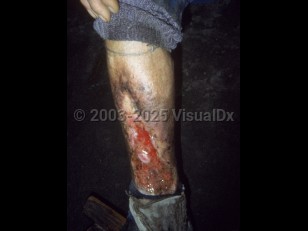Glanders
Alerts and Notices
Important News & Links
Synopsis

Glanders is an infection caused by Burkholderia mallei, a gram-negative bacillus. It is typically an equine disease. Glanders has been classified by the US Centers for Disease Control and Prevention (CDC) as a Category B bioterrorism agent due to the moderate ease with which it can be disseminated. If glanders were to be weaponized, the most likely method of dispersal would be by aerosol release.
Infection can be localized to the skin (chronic glanders) or mucous membranes (acute localized glanders) or manifest in the pulmonary system (acute pulmonary). It may begin as or progress to a septicemic form.
The acute pulmonary form would be most likely following a bioterrorism attack. Without treatment, any of the acute forms have a mortality rate of up to 95%. The overall mortality rate of all forms, even with treatment, is 40%.
Whether acquired naturally (via inhalation or hematogenous spread) or as a result of a bioterrorist attack, pulmonary glanders has an incubation period of 10-14 days and presents with a sudden onset of flu-like symptoms accompanied by fever, rigors, sweats, cough, chest pain, myalgias, lacrimation, diarrhea, photophobia, cervical adenopathy, splenomegaly, and a widespread papular / pustular rash similar to smallpox. It quickly progresses to pneumonia and/or pulmonary abscesses. Chest x-ray is positive for miliary nodules, infiltrates, and/or lung abscesses. Pulmonary glanders can occur as a result of septicemic spread from cutaneous disease followed by infection of lymph nodes and septicemia.
In acute localized glanders, the bacteria enter through breaks in the skin or mucosal surfaces of the eyes, nose, and mouth and cause conjunctivitis and/or bloody discharge of mucus and pus from the nose. Acute forms are almost always fatal without treatment.
Septicemic glanders is typically fatal within 7-10 days.
Glanders is transmitted through direct contact with an infected horse, donkey, or mule. The bacteria enter through the skin or the mucosal surfaces of the eyes, nose, and mouth or through inhalation. Person-to-person transmission is possible, including sexual transmission.
A prophylactic treatment for glanders is available.
Glanders is endemic in undeveloped countries in Asia, Africa, the Middle East, and South America. Since 1945, there have been only a handful of cases of glanders in the United States (in veterinarians and laboratory workers).
People at risk include veterinarians, equine pet owners, abattoir workers, workers in laboratories where the organism is being handled, and travelers to endemic areas.
Infection can be localized to the skin (chronic glanders) or mucous membranes (acute localized glanders) or manifest in the pulmonary system (acute pulmonary). It may begin as or progress to a septicemic form.
The acute pulmonary form would be most likely following a bioterrorism attack. Without treatment, any of the acute forms have a mortality rate of up to 95%. The overall mortality rate of all forms, even with treatment, is 40%.
Whether acquired naturally (via inhalation or hematogenous spread) or as a result of a bioterrorist attack, pulmonary glanders has an incubation period of 10-14 days and presents with a sudden onset of flu-like symptoms accompanied by fever, rigors, sweats, cough, chest pain, myalgias, lacrimation, diarrhea, photophobia, cervical adenopathy, splenomegaly, and a widespread papular / pustular rash similar to smallpox. It quickly progresses to pneumonia and/or pulmonary abscesses. Chest x-ray is positive for miliary nodules, infiltrates, and/or lung abscesses. Pulmonary glanders can occur as a result of septicemic spread from cutaneous disease followed by infection of lymph nodes and septicemia.
In acute localized glanders, the bacteria enter through breaks in the skin or mucosal surfaces of the eyes, nose, and mouth and cause conjunctivitis and/or bloody discharge of mucus and pus from the nose. Acute forms are almost always fatal without treatment.
Septicemic glanders is typically fatal within 7-10 days.
Glanders is transmitted through direct contact with an infected horse, donkey, or mule. The bacteria enter through the skin or the mucosal surfaces of the eyes, nose, and mouth or through inhalation. Person-to-person transmission is possible, including sexual transmission.
A prophylactic treatment for glanders is available.
Glanders is endemic in undeveloped countries in Asia, Africa, the Middle East, and South America. Since 1945, there have been only a handful of cases of glanders in the United States (in veterinarians and laboratory workers).
People at risk include veterinarians, equine pet owners, abattoir workers, workers in laboratories where the organism is being handled, and travelers to endemic areas.
Codes
ICD10CM:
A24.0 – Glanders
SNOMEDCT:
4639008 – Glanders
A24.0 – Glanders
SNOMEDCT:
4639008 – Glanders
Look For
Subscription Required
Diagnostic Pearls
Subscription Required
Differential Diagnosis & Pitfalls

To perform a comparison, select diagnoses from the classic differential
Subscription Required
Best Tests
Subscription Required
Management Pearls
Subscription Required
Therapy
Subscription Required
References
Subscription Required
Last Updated:04/01/2020
Glanders

